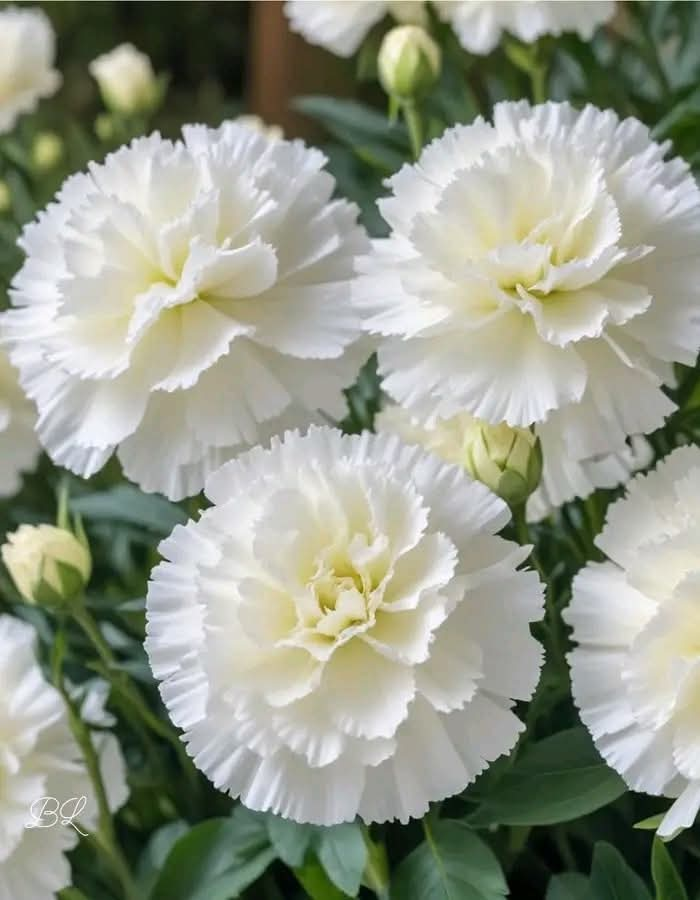Carnations, with their vibrant, ruffled petals and delicate fragrance, have long been a favorite among gardeners and florists. Known for their versatility and striking bicolored varieties, such as deep maroon blended with creamy white, these flowers add elegance to any garden or floral arrangement.
Why Grow Carnations?
Long-Lasting Blooms: Perfect for gardens and bouquets, carnations remain fresh for weeks.
Fragrant Flowers: Their light, sweet scent enhances the ambiance of any space.
Easy to Grow: Carnations thrive with minimal care, making them ideal for gardeners of all skill levels.
Versatile Uses: They’re beautiful in borders, containers, or as cut flowers.
Care Guide for Carnations
Light Requirements
Full Sun: Best for optimal growth and blooming.
Partial Shade: Can tolerate light shade, especially in hot climates.
Watering
Keep the soil consistently moist but not waterlogged.
Water at the base to avoid wetting the foliage, which can lead to disease.
Soil
Prefers rich, fertile, and well-draining soil.
Amend soil with compost or organic matter to boost fertility.
Temperature and Humidity
Thrives in temperatures between 60-75°F (16-24°C).
Prefers moderate to high humidity, but ensure good air circulation to prevent fungal issues.
Fertilizing
Use a balanced, slow-release fertilizer every 2-3 weeks during the growing season.
Avoid over-fertilizing, as it can lead to excessive foliage growth with fewer blooms.
Pruning and Deadheading
Deadhead spent blooms to encourage continuous flowering.
Trim back leggy growth to maintain a compact and tidy appearance.
How to Plant Carnations
From Seeds:
Start Indoors: Sow seeds 6-8 weeks before the last frost date.
Germination: Place seeds in moist soil and keep them in a warm spot (65-75°F).
Transplant: Move seedlings outdoors once they have 4-6 leaves and all danger of frost has passed.
From Cuttings:
Take Cuttings: Select healthy, non-flowering stems and cut 4-6 inches.
Plant in Soil: Dip the cut ends in rooting hormone and plant them in a moist potting mix.
Transplant: Move rooted cuttings to the garden or a larger container.
Common Issues and Solutions
Yellowing Leaves:
Cause: Overwatering or poor drainage.
Solution: Water less frequently and improve soil drainage.
Few Blooms:
Cause: Insufficient sunlight or excessive nitrogen.
Solution: Move to a sunnier spot and switch to a balanced fertilizer.
Fungal Diseases:
Cause: Poor air circulation or wet foliage.
Solution: Space plants properly and water at the base.
FAQs
How long do carnations bloom?
Carnations bloom for 2-3 months, with proper care and regular deadheading.
Are carnations perennial or annual?
Carnations are perennials in mild climates but may be grown as annuals in colder regions.
Can carnations grow in containers?
Yes! Ensure the container has good drainage and use a high-quality potting mix.
Do carnations attract pollinators?
Yes, their vibrant blooms attract bees, butterflies, and other pollinators.
Uses of Carnations
Garden Display: Perfect for borders, rock gardens, and containers.
Cut Flowers: Ideal for bouquets, centerpieces, and floral arrangements.
Symbolic Meanings: Represent love, admiration, and gratitude, making them popular for gifts and celebrations.
Final Thoughts
With their vibrant colors, ruffled petals, and easy care, carnations are a classic addition to any garden or bouquet. Their long-lasting blooms and delightful fragrance ensure they’ll remain a favorite for years to come. Whether you’re planting them in your garden or gifting a bouquet, carnations never fail to impress! 🌺✨
